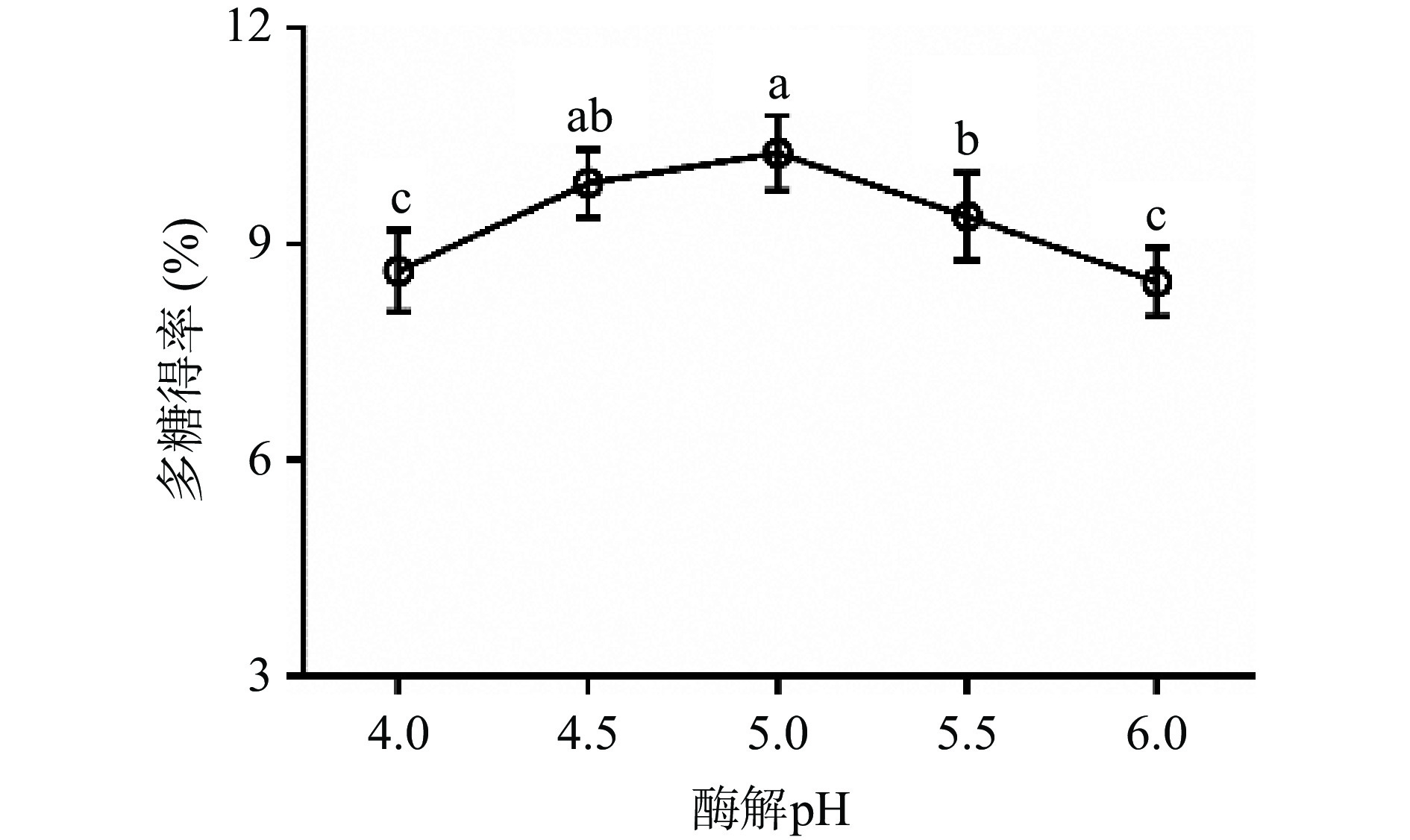Optimization of Cellulase Extraction Process of Crude Polysaccharide from Semen Cassiae and Study on Its Antioxidant Activity
-
摘要: 目的:优化纤维素酶法提取决明子粗多糖的工艺,并研究决明子粗多糖的体外抗氧化活性。方法:在单因素实验的基础上,以酶解时间、酶解温度、酶用量、液料比及酶解pH为自变量,多糖得率为响应值,利用Box-Behnken响应面法进行工艺优化。以对DPPH自由基和羟自由基清除率的大小为指标考察决明子粗多糖的体外抗氧化活性。结果:纤维素酶法提取决明子粗多糖最佳工艺为酶用量1.4%、酶解时间50 min、液料比24:1 mL/g、酶解pH5.4、酶解温度48 ℃,此条件下决明子多糖得率为11.67%,与回归模型的理论预测值11.91%误差小于5%。决明子粗多糖对DPPH自由基和羟自由基均具有较强的清除作用,半数抑制浓度分别为1.025 mg/mL和0.894 mg/mL。结论:纤维素酶法可显著提高决明子粗多糖得率,工艺简便可行,获得的决明子粗多糖具有体外抗氧化活性。Abstract: Objective: To optimize the cellulase extraction process of crude polysaccharide from Semen Cassiae and study its antioxidant activity in vitro. Methods: On the basis of single factor test results, Box-Behnken response surface methodology was used to optimize the extraction process of crude polysaccharide from Semen Cassiae with enzymolysis time, enzymolysis temperature, enzyme dosage, liquid-to-material ratio and enzymolysis pH as independent variables, and the yield of polysaccharide as response value. DPPH radical and hydroxyl radical scavenging rates were used to investigate the antioxidant activities of crude polysaccharides from Semen Cassiae in vitro. Results: The optimal cellulase extraction conditions of crude polysaccharide from Semen Cassiae were as follows: Enzyme dosage was 1.4%, enzymolysis time was 50 min, liquid-to-material ratio was 24:1 mL/g, enzymolysis pH was 5.4, and enzymolysis temperature was 48 ℃. Under these conditions, the yield of polysaccharide from Semen Cassiae was 11.67%, and the theoretical prediction value of regression model was 11.91%, the error between the two conditions was less than 5%. Crude polysaccharide from Semen Cassiae had strong scavenging effects on DPPH free radical and hydroxyl free radical, with median inhibitory concentrations of 1.025 mg/mL and 0.894 mg/mL, respectively. Conclusion: Cellulase enzymatic method can significantly improve the yield of crude polysaccharide from Semen Cassiae, the process is simple and feasible, and the crude polysaccharide obtained from Semen Cassiae has antioxidant activity in vitro.
-
决明子是豆科植物决明(Cassia tora Linn.)或小决明的成熟种子[1],是我国传统中药材,具有食用和药用双重价值,主要分布于长江以南地区,主产于安徽、广西等地[2]。决明子中蒽醌类含量较多,还含有萘并吡喃酮、多糖和脂肪酸等活性成分[1, 3]。现代药理研究表明,决明子具有降血脂[4-5]、降血压[6]、降血糖[7-8]、保肝明目[9-10]、润肠通便[11]、抗氧化[12-13]等作用。决明子作为卫健委公布的药食同源物种,在我国分布广泛、价格低廉,具有较好的开发前景。
天然多糖类药物相比化学合成药物,具有低毒副作用、多途径、多靶点等作用优势[14-15]。决明子多糖具有抗氧化[16]、抗疲劳[17]、保护视网膜[18]、增强免疫[19]等多种生物活性。决明子多糖传统提取方法存在多糖提取率低、结构受到破坏等问题。目前决明子粗多糖提取采用的方法有水浸提法和超声提取法,研究指出超声波辅助浸提决明子多糖,多糖得率范围为5.88%~10.74%[20-22]。另有研究表明热水浸提法提取决明子水溶性多糖,得率可达10.45%[23],水提醇沉法提取决明子粗多糖,多糖产率为9.17%,并指出决明子粗多糖对羟自由基和超氧阴离子自由基具有一定的清除作用[24]。酶提取法具有反应条件温和,不需要有机溶剂等特点[25-26]。纤维素酶通过分解细胞壁的主要组成成分纤维素,破坏植物细胞结构的完整性,加速胞内多糖的释放与溶出,提高多糖得率[27]。经文献查阅,至今未见酶法提取决明子粗多糖的相关报道。
本研究以酶解时间、酶解温度、酶用量、液料比及酶解pH为自变量,多糖得率为响应值,采用响应面法优化纤维素酶法提取决明子粗多糖的工艺,并探究其体外抗氧化活性,以期为决明子多糖的进一步开发利用提供科学依据。
1. 材料与方法
1.1 材料与仪器
决明子 广西玉林中药港,经玉林师范学院陈晓白教授鉴定为豆科植物决明(Cassia tora Linn.)的成熟干燥种子,2021年10月采收;纤维素酶(5万U/g) 北京索莱宝科技有限公司;1,1-二苯基-2-苦肼基自由基(DPPH) 上海阿拉丁生化科技股份有限公司;葡萄糖分析对照品、维生素C分析标准品 上海麦克林生化科技有限公司;柠檬酸、柠檬酸钠、硫酸亚铁、过氧化氢、邻二氮菲 均为国产分析纯,西陇化工股份有限公司。
FW135中药粉碎机 天津市泰斯特仪器;RV-211A旋转蒸发仪 上海一恒科学仪器;SHY-2A水浴恒温振荡器 常州国宇仪器;FA1004B电子分析天平 上海佑科仪器仪表;PHSJ-6L pH计 上海仪电科学仪器;H1580高速台式离心机 湖南湘仪实验室仪器;TU-1901紫外可见分光光度计 北京普析通用仪器。
1.2 实验方法
1.2.1 决明子粗多糖的提取
干燥决明子粉碎过80目筛,称取适量粉末,石油醚浸泡脱脂48 h,滤渣挥干后,加入一定浓度的纤维素酶水溶液在特定温度下提取,结束后沸水浴灭活10 min。酶提取液过滤,旋转蒸发浓缩至100 mL,在浓缩液中加入无水乙醇至浓度为80%进行沉淀,4 ℃冰箱静置12 h,4000 r/min离心15 min后弃上清液,沉淀复溶于水,加入1/3体积的Sevage试剂(氯仿:正丁醇=4:1),混合振荡20 min,静置,保留上层清液,用80%乙醇进行二次醇沉,离心保留沉淀,沉淀加水溶解,−50 ℃下冻干,获得决明子粗多糖[28-29]。
1.2.2 总糖含量的测定
总糖测定采用苯酚-硫酸法[30-31],精密称取葡萄糖对照品和决明子粗多糖,用蒸馏水进行梯度稀释,分别向不同浓度葡萄糖溶液和决明子粗多糖溶液中加入5%苯酚溶液1 mL及浓硫酸5 mL,充分混匀,静置30 min后于490 nm处测吸光度。葡萄糖标准曲线方程为y=1.1602x+0.0286,R2=0.9978,式中:y为490 nm条件下的吸光度值,x为葡萄糖质量浓度(mg/mL)。
多糖得率(%)=cnVm×100 式中:c为样品稀释液中多糖的浓度(mg/mL);n为稀释倍数;V为样品稀释液体积(mL);m为决明子粉末质量(mg)。
1.2.3 单因素实验
准确称取50 g决明子粉末,按液料比(10:1、15:1、20:1、25:1、30:1 mL/g)加入蒸馏水,搅拌均匀,添加一定量的纤维素酶(0.8%、1.2%、1.6%、2.0%、2.4%),柠檬酸-柠檬酸钠缓冲液调节pH(4.0、4.5、5.0、5.5、6.0),分别在不同温度下(44、48、52、56、60 ℃)酶解处理一定时间(40、80、120、160、200 min),纤维素酶酶解完毕后,按照方法1.2.1步骤提取粗多糖。单因素实验以多糖得率为考察指标,优化某一条件时,其它条件固定值分别为酶用量1.2%,酶解pH5.0,酶解温度48 ℃,液料比20:1 mL/g,酶解时间80 min,摇床速度为180 r/min。
1.2.4 响应面优化试验
根据单因素实验结果,以酶解时间、酶用量、液料比及酶解pH为自变量,多糖得率为响应值,利用Box-Behnken响应面法对提取工艺进行优化,设计四因素三水平,见表1。
表 1 响应面设计因素与水平Table 1. Experimental design factors and levels of response surface methodology水平 因素 A 酶解时间(min) B 酶用量(%) C 液料比(mL/g) D 酶解pH −1 50 0.8 16:1 4.6 0 80 1.2 20:1 5.0 1 110 1.6 24:1 5.4 1.2.5 抗氧化活性分析
1.2.5.1 决明子粗多糖清除DPPH自由基能力检测
决明子粗多糖体外抗氧化活性检测及自由基清除率计算均参照陈红惠等[32]的方法进行。样品溶液检测前使用蒸馏水配成0.2、0.4、0.8、1.2、1.6、2.0、2.4 mg/mL不同浓度。DPPH自由基(DPPH•)清除能力检测使2.0 mL样品溶液与2.0 mL 0.1 mmol/mL的DPPH甲醇溶液充分混匀,室温避光静置30 min后检测其在515 nm波长处的吸光度值A1,同法测定2.0 mL甲醇加样液的吸光度值A2,及2.0 mL DPPH溶液与2.0 mL蒸馏水的吸光度值A0。以等体积相同浓度维生素C溶液代替样品溶液作为阳性对照。
DPPH自由基清除率(%)=(1−A1−A2A0)×100 1.2.5.2 决明子粗多糖清除羟自由基能力检测
羟自由基(•OH)清除能力检测使2.0 mL样品溶液与2.0 mL 9.0 mmol/L的FeSO4溶液、1.0 mL 0.75 mmol/L的邻二氮菲溶液充分混匀后静置10 min,再向混合溶液中加入2.0 mL 6.0 mmol/L的过氧化氢溶液,37 ℃水浴30 min后检测其在510 nm波长处的吸光度值B1,用蒸馏水代替过氧化氢测定吸光度值B2,用蒸馏水代替样品溶液测定吸光度值B0。以等体积相同浓度维生素C溶液代替样品溶液作为阳性对照。
羟自由基清除率(%)=(1−B1−B2B0)×100 1.3 数据处理
实验重复3次,数据以平均值±标准差表示;采用SPSS 20.0进行差异显著性分析;使用GraphPad Prism 6.0.1绘图;使用Design Expert 12.0.3.0软件进行响应面试验设计和数据分析。
2. 结果与分析
2.1 单因素实验
2.1.1 酶用量对决明子多糖得率的影响
随着酶用量从0.8%增大至2.0%,决明子多糖得率提高,酶用量为1.2%时,得率达到9.21%,酶用量进一步增加至2.0%时,得率为9.73%,提升幅度不大,与酶用量1.6%得率相比差异不显著(P>0.05),进一步添加纤维素酶至2.4%,与1.6%和2.0%比较,多糖得率差异均无显著变化(P>0.05),说明此时酶已达到饱和状态。考虑未来工艺放大后的实际生产成本,故选择1.2%为最适酶用量,见图1。
2.1.2 酶解温度对决明子多糖得率的影响
与44 ℃比较,48 ℃多糖得率显著增大(P<0.05),当再进一步提高温度至52、56和60 ℃时,多糖得率则明显减小,与48 ℃比较均具有显著性差异(P<0.05)。原因在于温度过高或过低,都不利于酶活性的发挥。纤维素酶法提取决明子粗多糖的最适温度为48 ℃,此时得率达到最大值10.06%,见图2。
2.1.3 酶解pH对决明子多糖得率的影响
随着pH从4.0增大到5.0,决明子多糖得率提高,当pH为5.0时,得率达到最大值10.26%,与pH4.0比较差异具有显著性(P<0.05),再进一步提高pH至5.5或6.0,两者的多糖得率反而明显减小,与pH5.0比较,差异均具有统计学意义(P<0.05)。因为在最适pH时,酶分子上活性基团的解离状态最适于与底物结合,酶反应速率最大。故选择5.0为最佳酶解pH,见图3。
2.1.4 酶解时间对决明子多糖得率的影响
随着酶解时间从40 min增加至120 min,决明子多糖得率提高,酶解时间为80 min时,得率达到9.61%,酶解时间进一步延长至160 min时,得率增幅很小,与酶解时间120 min得率比较差异无统计学意义(P>0.05),再进一步增加时间至200 min,多糖得率反而显著下降(P<0.05),这是由于酶解提取时间过长会导致酶催化活性减弱和多糖水解。考虑到实际生产效率,故选择80 min为最佳酶解时间,见图4。
2.1.5 液料比对决明子多糖得率的影响
决明子多糖得率随液料比的增大而增大,当液料比为20:1 mL/g时,多糖得率达最大值9.82%,与液料比10:1、15:1 mL/g相比,均具有显著性差异(P<0.05),进一步增大液料比至25:1或30:1 mL/g,决明子多糖得率反而明显降低。这可以解释为,合适的液料比有利于更有针对性地使组分浸出到水中,从而提高得率,但液料比太大带来大量溶剂,会造成能量浪费、后续溶液浓缩工作量增加及多糖的损失,进而使多糖得率减小,见图5。
2.2 响应面试验
具体试验结果见表2,方差分析结果见表3。通过回归拟合,获得决明子多糖得率(Y)与自变量(酶解时间、酶用量、液料比、酶解pH)的二次多项回归方程:Y=10.69−0.26A+0.21B+0.32C+0.65D+0.20AB−0.29AC−0.42AD+0.12BC−0.04BD+0.19CD+0.05A2−0.11B2−0.30C2−0.68D2。回归方程模型P<0.0001,失拟项不显著(P=0.8009),模型总决定系数R2=0.9216,变异系数C.V.%值为2.70,以上参数均说明该模型与试验数据拟合程度好,试验误差小,可用于不同变量条件下的响应值预测。四个因素对决明子粗多糖纤维素酶法提取的影响均显著(P<0.05),其中酶解pH(D)影响最大、液料比(C)和酶解时间(A)次之、酶用量(B)影响最小。表3和图6结果表明,AD间交互作用对纤维素酶法提取决明子粗多糖的影响极显著(P<0.01),AB、AC、BC、BD、CD间交互作用则对多糖得率的影响均不显著(P>0.05)。
表 2 响应面试验设计与结果Table 2. Design and results of response surface test试验号 A B C D 多糖得率(%) 1 −1 0 0 1 11.2 2 0 1 0 −1 9.4 3 0 0 1 1 11.2 4 0 −1 1 0 10.1 5 0 0 0 0 10.3 6 −1 0 0 −1 9.2 7 −1 1 0 0 10.8 8 1 0 1 0 9.9 9 0 1 −1 0 10.2 10 0 −1 −1 0 9.9 11 0 1 1 0 10.9 12 0 0 0 0 10.7 13 0 −1 0 −1 8.8 14 0 1 0 1 10.7 15 0 0 0 0 11.1 16 0 0 −1 1 9.9 17 0 0 0 0 10.9 18 1 0 0 −1 9.7 19 1 −1 0 0 10.3 20 −1 0 −1 0 10.2 21 1 1 0 0 10.9 22 −1 −1 0 0 11.0 23 0 0 0 0 10.4 24 0 0 −1 −1 8.9 25 1 0 −1 0 9.9 26 1 0 0 1 10.0 27 0 −1 0 1 10.2 28 0 0 1 −1 9.3 29 −1 0 1 0 11.3 表 3 方差分析结果Table 3. Results of ANOVA analysis来源 平方和 自由度 均方 F值 P值 显著性 模型 12.62 14 0.90 11.76 <0.0001 ** A 0.83 1 0.83 10.79 0.0054 ** B 0.53 1 0.53 6.85 0.0203 * C 1.22 1 1.22 15.87 0.0014 ** D 5.12 1 5.12 66.86 <0.0001 ** AB 0.16 1 0.16 2.09 0.1704 AC 0.32 1 0.32 4.24 0.0586 AD 0.71 1 0.71 9.32 0.0086 ** BC 0.06 1 0.06 0.75 0.4005 BD 0.01 1 0.01 0.09 0.7633 CD 0.14 1 0.14 1.88 0.1914 A2 0.01 1 0.01 0.19 0.6660 B2 0.08 1 0.08 1.06 0.3199 C2 0.59 1 0.59 7.66 0.0151 * D2 3.03 1 3.03 39.54 <0.0001 ** 残差 1.07 14 0.08 失拟项 0.62 10 0.06 0.55 0.8009 纯误差 0.45 4 0.11 总和 13.69 28 注:*P<0.05显著,**P<0.01极显著。 通过求解回归模型方程,得到决明子粗多糖纤维素酶法提取的最佳工艺:酶解时间50 min、酶用量1.361%、液料比24:1 mL/g、酶解pH为5.365,此条件下多糖得率的理论值为11.91%。为便于实际操作,将最佳工艺修改为酶解时间50 min、酶用量1.4%、液料比24:1 mL/g、酶解pH5.4,根据此工艺进行3次验证实验,获得的多糖得率均值为11.67%±0.45%,与理论值相对误差为2.01%,说明回归模型有效可靠,纤维素酶法提取决明子粗多糖工艺具有实际应用价值。
2.3 抗氧化活性
2.3.1 决明子粗多糖对DPPH•的清除作用
结果如图7所示,决明子粗多糖对DPPH•的清除率随着粗多糖质量浓度的增加而明显增大,当粗多糖浓度为2.0 mg/mL时,DPPH•清除率为80.91%,当粗多糖浓度提高至2.4 mg/mL时,清除率达到82.51%。决明子粗多糖和维生素C对DPPH•的半数抑制浓度分别为1.025、0.136 mg/mL。结果表明决明子粗多糖对DPPH•有较强的清除作用,但其体外抗氧化活性弱于维生素C。
2.3.2 决明子粗多糖对•OH的清除作用
结果如图8所示,决明子粗多糖对•OH的清除率随着粗多糖质量浓度的增加而明显增大,当粗多糖浓度为2.4 mg/mL时,•OH清除率达到80.64%。决明子粗多糖和维生素C对•OH的半数抑制浓度分别为0.894、0.207 mg/mL。结果表明决明子粗多糖对•OH有较强的清除作用,但其体外抗氧化活性弱于维生素C。
3. 结论
本文通过响应面法优化了纤维素酶法提取决明子粗多糖的工艺,获得最佳工艺为酶用量1.4%、酶解时间50 min、液料比24:1 mL/g、酶解pH5.4、酶解温度48 ℃,此条件下决明子多糖得率为11.67%,与回归模型理论预测值的误差小于5%。本研究获得的决明子多糖得率明显高于文献报道中超声辅助提取法的决明子多糖得率[20-22]。本研究也发现决明子粗多糖对DPPH•和•OH具有较强的清除作用,这与相关文献报道结果一致,本文研究结果为将决明子多糖开发为保健品或食品添加剂奠定一些理论基础。
-
表 1 响应面设计因素与水平
Table 1 Experimental design factors and levels of response surface methodology
水平 因素 A 酶解时间(min) B 酶用量(%) C 液料比(mL/g) D 酶解pH −1 50 0.8 16:1 4.6 0 80 1.2 20:1 5.0 1 110 1.6 24:1 5.4 表 2 响应面试验设计与结果
Table 2 Design and results of response surface test
试验号 A B C D 多糖得率(%) 1 −1 0 0 1 11.2 2 0 1 0 −1 9.4 3 0 0 1 1 11.2 4 0 −1 1 0 10.1 5 0 0 0 0 10.3 6 −1 0 0 −1 9.2 7 −1 1 0 0 10.8 8 1 0 1 0 9.9 9 0 1 −1 0 10.2 10 0 −1 −1 0 9.9 11 0 1 1 0 10.9 12 0 0 0 0 10.7 13 0 −1 0 −1 8.8 14 0 1 0 1 10.7 15 0 0 0 0 11.1 16 0 0 −1 1 9.9 17 0 0 0 0 10.9 18 1 0 0 −1 9.7 19 1 −1 0 0 10.3 20 −1 0 −1 0 10.2 21 1 1 0 0 10.9 22 −1 −1 0 0 11.0 23 0 0 0 0 10.4 24 0 0 −1 −1 8.9 25 1 0 −1 0 9.9 26 1 0 0 1 10.0 27 0 −1 0 1 10.2 28 0 0 1 −1 9.3 29 −1 0 1 0 11.3 表 3 方差分析结果
Table 3 Results of ANOVA analysis
来源 平方和 自由度 均方 F值 P值 显著性 模型 12.62 14 0.90 11.76 <0.0001 ** A 0.83 1 0.83 10.79 0.0054 ** B 0.53 1 0.53 6.85 0.0203 * C 1.22 1 1.22 15.87 0.0014 ** D 5.12 1 5.12 66.86 <0.0001 ** AB 0.16 1 0.16 2.09 0.1704 AC 0.32 1 0.32 4.24 0.0586 AD 0.71 1 0.71 9.32 0.0086 ** BC 0.06 1 0.06 0.75 0.4005 BD 0.01 1 0.01 0.09 0.7633 CD 0.14 1 0.14 1.88 0.1914 A2 0.01 1 0.01 0.19 0.6660 B2 0.08 1 0.08 1.06 0.3199 C2 0.59 1 0.59 7.66 0.0151 * D2 3.03 1 3.03 39.54 <0.0001 ** 残差 1.07 14 0.08 失拟项 0.62 10 0.06 0.55 0.8009 纯误差 0.45 4 0.11 总和 13.69 28 注:*P<0.05显著,**P<0.01极显著。 -
[1] 于凡, 孙乐, 许利嘉, 等. 决明子现代应用的研究进展[J]. 中国现代中药,2018,20(5):626−630. [YU F, SUN L, XU L J, et al. Research progress on modern application of Cassiae semen[J]. Modern Chinese Medicine,2018,20(5):626−630. [2] 董玉洁, 蒋沅岐, 刘毅, 等. 决明子的化学成分、药理作用及质量标志物预测分析[J]. 中草药,2021,52(9):2719−2732. [DONG Y J, JIANG Y Q, LIU Y, et al. Research progress on chemical composition and pharmacological effects of Cassiae semen and predictive analysis on quality markers[J]. Chinese Traditional and Herbal Drugs,2021,52(9):2719−2732. [3] ZHANG M, LI X, LIANG H, et al. Semen Cassiae extract improves glucose metabolism by promoting GlUT4 translocation in the skeletal muscle of diabetic rats[J]. Frontiers in Pharmacology,2018,9:235. doi: 10.3389/fphar.2018.00235
[4] LEE J Y, LIAO W L, LIU Y H, et al. Oral administration of processed Cassia obtusifolia L. seed powder may reduce body weight and cholesterol in overweight patients with schizophrenia: A 36-week randomized, double-blind, controlled trial of high and low doses[J]. Journal of Ethnopharmacology,2022,292:115111. doi: 10.1016/j.jep.2022.115111
[5] 朱周靓, 张世鑫, 郑云燕, 等. 决明子提取物对高脂血症大鼠血脂和肝肾功能的影响[J]. 预防医学,2021,33(12):1290−1294. [ZHU Z L, ZHANG S X, ZHENG Y Y, et al. Effects of extract from Cassiae semen on blood lipid and liver and kidney function in hyperlipidemia rats[J]. Preventive Medicine,2021,33(12):1290−1294. [6] 高小敏, 赵勤. 应用网络药理学预测决明子治疗高血压的作用机制[J]. 大理大学学报,2021,6(8):11−15. [GAO X M, ZHAO Q. Application of network pharmacology to predict the mechanism of Semen cassiae in the treatment of hypertension[J]. Journal of Dali University,2021,6(8):11−15. doi: 10.3969/j.issn.2096-2266.2021.08.003 [7] WANG Q Y, ZHOU J W, XIANG Z N, et al. Anti-diabetic and renoprotective effects of Cassiae semen extract in the streptozotocin-induced diabetic rats[J]. Journal of Ethnopharmacology,2019,239:111904. doi: 10.1016/j.jep.2019.111904
[8] WANG Q Y, TONG A H, PAN Y Y, et al. The effect of Cassia seed extract on the regulation of the LKB1-AMPK-GLUT4 signaling pathway in the skeletal muscle of diabetic rats to improve the insulin sensitivity of the skeletal muscle[J]. Diabetology Metabolic Syndrome,2019,11(1):108. doi: 10.1186/s13098-019-0504-0
[9] LUO H Y, WU H W, WANG L X, et al. Hepatoprotective effects of Cassiae semen on mice with non-alcoholic fatty liver disease based on gut microbiota[J]. Communications Biology,2021,4(1):1357. doi: 10.1038/s42003-021-02883-8
[10] HE S Q, MA X, MENG Q G, et al. Effects and mechanisms of water-soluble Semen Cassiae polysaccharide on retinitis pigmentosa in rats[J]. Food Science and Technology,2020,40(1):84−88. doi: 10.1590/fst.32718
[11] 杨冰, 任娟, 秦昆明, 等. 决明子药理作用及其机制研究进展[J]. 中药材,2018,41(5):1247−1251. [YANG B, REN J, QIN K M, et al. Research progress on pharmacological action and mechanism of Semen cassiae[J]. Journal of Chinese Medicinal Materials,2018,41(5):1247−1251. [12] LIU C, LIU Q, SUN J, et al. Extraction of water-soluble polysaccharide and the antioxidant activity from Semen Cassiae[J]. Journal of Food and Drug Analysis,2014,22(4):492−499. doi: 10.1016/j.jfda.2014.01.027
[13] ZENG H, LIU Q, WANG M, et al. Target-guided separation of antioxidants from Semen Cassia via off-line two-dimensional high-speed counter-current chromatography combined with complexation and extrusion elution mode[J]. Journal of Chromatography B,2015,1001:58−65. doi: 10.1016/j.jchromb.2015.07.046
[14] 曲航, 高鑫, 伊娟娟, 等. 食源性天然产物对酒精性肝损伤的防护作用研究进展[J]. 食品科学,2020,41(17):283−290. [QU H, GAO X, YI J J, et al. Review on the protective effects of food-derived natural compounds on alcohol-induced liver injury[J]. Food Science,2020,41(17):283−290. doi: 10.7506/spkx1002-6630-20190920-262 [15] 肖莲, 杨道斌, 陈礼大, 等. 中药复方多成分多靶点协同增效药理药效评价[J]. 中医药研究前沿,2022,4(1):16−18. [XIAO L, YANG D B, CHEN L D, et al. Pharmacological efficacy evaluation of multi-component and multi-target synergistic synergy of compound prescription of TCM[J]. Frontiers of Chinese Medicine Research,2022,4(1):16−18. doi: 10.12238/fcmr.v4i1.5193 [16] WU D T, LIU W, HAN Q H, et al. Extraction optimization, structural characterization, and antioxidant activities of polysaccharides from Cassia seed (Cassia obtusifolia)[J]. Molecules,2019,24(15):2817. doi: 10.3390/molecules24152817
[17] KANG C Z, LIU Y N, CHI A P, et al. The anti-fatigue potential of water-soluble polysaccharides of Semen Cassiae on BALB/c mice[J]. Cellular and Molecular Biology,2021,67(2):148−154. doi: 10.14715/cmb/2021.67.2.23
[18] SUN M M, HE N, LYU Z G. Polysaccharides extracted from Cassia seeds protect against high glucose-induced retinal endothelial cell injury[J]. International Ophthalmology,2021,41(7):2465−2472. doi: 10.1007/s10792-021-01801-5
[19] FENG L, YIN J Y, NIE S P, et al. Fractionation, physicochemical property and immunological activity of polysaccharides from Cassia obtusifolia[J]. International Journal of Biological Macromolecules,2016,91:946−953. doi: 10.1016/j.ijbiomac.2016.05.030
[20] 王涛. 决明子多糖提取工艺研究[J]. 轻工标准与质量,2014,13(2):49−51. [WANG T. Study on extraction technology of polysaccharide from Semen Cassiae[J]. Standard & Quality of Light Industry,2014,13(2):49−51. [21] 康佩姿, 梁磊, 黄清铧, 等. 响应面法优化决明子水溶性多糖提取条件研究[J]. 粮食与油脂,2015,28(11):63−67. [KANG P Z, LIANG L, HUANG Q H, et al. Optimization of ultrasonic extraction of polysaccharides from Cassia seeds[J]. Cereals & Oils,2015,28(11):63−67. [22] 杨黎燕. 决明子功效成分—蒽醌、多糖的提取及分析方法研究[D]. 西安: 西北大学, 2003: 1−8 YANG L Y. Study on the extraction and analysis methods of functional components of Cassia seeds-anthraquinone and polysaccharide[D]. Xi’an: Northwest University, 2003: 1−8.
[23] 邓泽元, 刘娟, 余迎利, 等. 决明子水溶性多糖提取的研究[J]. 食品科学,2002,23(1):72−75. [DENG Z Y, LIU J, YU Y L, et al. Study on extraction of water-soluble polysaccharide from Cassia seeds[J]. Food Science,2002,23(1):72−75. doi: 10.3321/j.issn:1002-6630.2002.01.016 [24] 郭晓强, 颜军, 邬晓勇, 等. 决明子水溶性多糖的纯化及抗氧化活性研究[J]. 食品科学,2007,28(8):205−208. [GUO X Q, YAN J, WU X Y, et al. Study on purification and antioxidation of water-soluble polysaccharide isolated from Semen Cassia[J]. Food Science,2007,28(8):205−208. doi: 10.3321/j.issn:1002-6630.2007.08.046 [25] 周晓红, 陈洁冰, 罗智, 等. 纤维素酶辅助提取茶多糖的工艺研究[J]. 湖南城市学院学报(自然科学版),2022,31(1):67−71. [ZHOU X H, CHEN J B, LUO Z, et al. Study on the extraction technology of tea polysaccharides assisted by cellulose[J]. Journal of Hunan City University (Natural Science),2022,31(1):67−71. doi: 10.3969/j.issn.1672-7304.2022.01.0011 [26] LIU X X, GU L B, ZHANG G J, et al. Structural characterization and antioxidant activity of polysaccharides extracted from Chinese yam by a cellulase-assisted method[J]. Process Biochemistry,2022,121:178−187. doi: 10.1016/j.procbio.2022.06.023
[27] GUO L, TAN D C, HUI F Y, et al. Optimization of the cellulase-ultrasonic synergistic extraction conditions of polysaccharides from Lenzites betulina[J]. Chemistry & Biodiversity,2019,16(11):e1900369.
[28] 蒋德旗, 柒善怀, 张兰熙, 等. 响应面法优化金果榄多糖提取工艺及抗氧化活性研究[J]. 中国中医药信息杂志,2019,26(4):85−90. [JIANG D Q, QI S H, ZHANG L X, et al. Optimization of extraction process of polysaccharide from Tinosporae radix by response surface method and study on its antioxidant activity[J]. Chinese Journal of Information on TCM,2019,26(4):85−90. doi: 10.3969/j.issn.1005-5304.2019.04.018 [29] 龚频, 王佩佩, 同美霖, 等. 红枣多糖的提取工艺及药理活性研究[J]. 食品工业科技,2022,43(13):198−207. [GONG P, WANG P P, TONG M L, et al. Study on extraction technology and pharmacological activities of polysaccharide from Ziziphus jujube[J]. Science and Technology of Food Industry,2022,43(13):198−207. [30] 蒋德旗, 陈晓白, 农贵珍, 等. 鸡骨草多糖的酶法提取工艺优化及其抗氧化活性[J]. 食品工业科技,2019,40(3):153−158. [JIANG D Q, CHEN X B, NONG G Z, et al. Optimization of enzymatic extraction of polysaccharide from Abrus cantoniensis Hance and its antioxidant activity[J]. Science and Technology of Food Industry,2019,40(3):153−158. [31] 叶兆伟, 叶润, 赫丁轩, 等. 息半夏多糖提取工艺优化及其抗氧化活性研究[J]. 中国食品添加剂,2022,33(1):90−98. [YE Z W, YE R, HE D X, et al. Optimization of polysaccharide extraction from Xi Pinellia ternate by response surface methodology and its antioxidant activity[J]. China Food Additives,2022,33(1):90−98. [32] 陈红惠, 牛念拉姆. 底圩茶多糖的超声波辅助提取及其抗氧化活性[J]. 食品工业科技,2020,41(21):179−184. [CHEN H H, NIUNIAN L M. Ultrasonic extraction and antioxidant activity of polysaccharide from Dixu tea[J]. Science and Technology of Food Industry,2020,41(21):179−184. -
期刊类型引用(3)
1. 曾臻,上官雪茹,蔡依婕,丰艳,吴伟菁,吴兰兰,何义姝,林木丁,谭强来. 新型重组海洋抗菌肽制备与评价的综合实验设计. 食品与药品. 2025(02): 185-190 .  百度学术
百度学术
2. 曾臻,罗家英,蔡依婕,上官雪茹,黄艺虹,李雅婷,李婉褀,谭强来. 四联鲎抗菌肽Tachyplesin Ⅱ毕赤酵母重组质粒构建及其表达. 科技创新与应用. 2024(07): 47-50 .  百度学术
百度学术
3. 苏琰,李融. 抗菌肽的食品保鲜应用及生物合成研究进展. 食品与机械. 2024(07): 208-215 .  百度学术
百度学术
其他类型引用(3)






 下载:
下载:










 下载:
下载:



